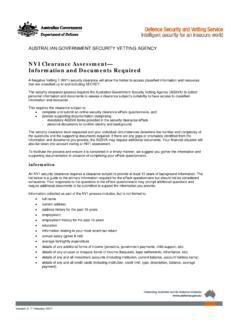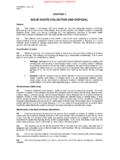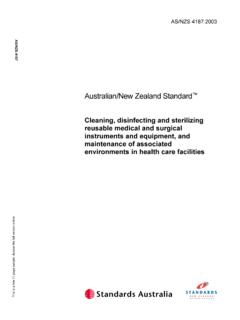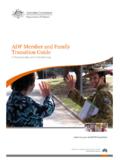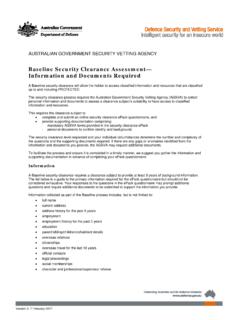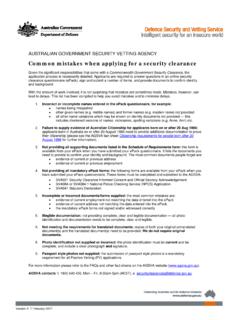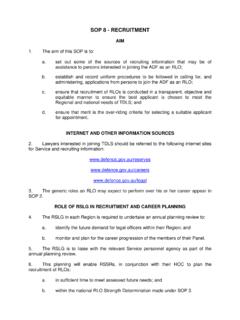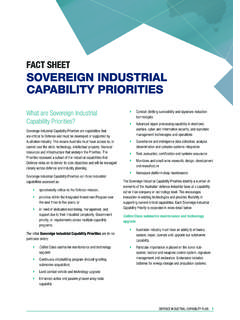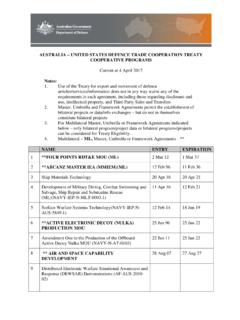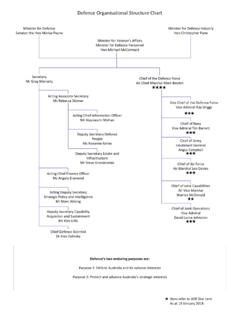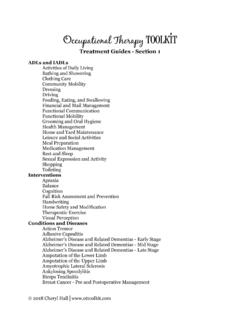Transcription of Centre for Military and Veterans’ Health
1 Centre for Military and veterans ' Health The Middle East Area of Operations (MEAO) Health Study: Prospective Study Summary Report 14 December 2012 i CMVH Director Professor Peter Warfe CSC. MEAO Health Study Investigators Membership of the Investigators' Committee changed over the course of the study. Professor Annette Dobson AM, The University of Queensland (First Chief Investigator from March 2011, previously committee member from the beginning of the study in 2007) Professor Alexander McFarlane AO, CMVH University of Adelaide (First Chief Investigator from 2007 to March 2011) Professor Malcolm Sim, Monash University (resigned April 2011) Associate Professor Susan Treloar, CMVH, The University of Queensland Dr Keith Horsley, Adjunct Associate Professor, CMVH, The University of Queensland COL Stephanie Hodson, Director of Mental Health , Department of Defence Professor Philip Ryan, University of Adelaide (from March 2011, previously Associate Investigator) Professor Harvey Whiteford, The University of Queensland (from March 2011 to March 2012) Dr.
2 Ian Gardner, Defence Centre for Occupational Health (from March 2011) Dr. Carol Davy, CMVH, University of Adelaide (from March 2011) Professor Beverley Raphael (from March 2012) Research Team Dr. Ellie Lawrence Wood Ms. Maria Abraham Professor Richard Clark Mr Andrew Lawrence Associate Professor Alan Crockett Ms Laura Jones Ms Michelle Lorimer Ms Jenelle Baur Dr. Kathryn Moores Ms Elizabeth Saccone Dr Thao Tran Mr Derek Browne Mr Roger Glenny Mr Daniel Barnes Ms Emma Laurence Suggested Citation Davy C, Dobson A, Lawrence Wood E, Lorimer M, Moores K, Lawrence A, Horsley K, Crockett A, McFarlane A 2012. The Middle East Area of Operations (MEAO) Health Study: Prospective Study Summary Report. The University of Adelaide, Centre for Military and veterans Health , Adelaide, Australia.
3 Acknowledgments We would like to thank the following people and organisations for their assistance. Department of Defence Program Management Board: Members past and present, chaired by BRIG Stephan Rudzki (until September, 2012) Scientific Advisory Committee: Currently chaired by Professor Michael Moore; Professor (Tony) McMichael (past Chair), Professor A. Scott Henderson (current), Associate Professor Tim Driscoll (current), Professor Helen Berry (current), Professor Neil Pearce (past), Associate Professor Emily Banks (past), Professor Louisa Jorm (past) Program Management Office staff past and present in Joint Health Command and in particular Ms Maxine Baban, for support and facilitation of the study. CMVH Defence Liaison Officers: GPCAPT Geoffrey Robinson, WGCDR Merilyn White, MAJ Mathew Carroll, LCDR Steven Pullman, SQNLDR Michel Devine, FLTSGT Yvette Davey, FLTLT Sally Breckenridge, SQNLDR Dean Leck, for co ordination of visits to Defence bases during the MilHOP studies.
4 I Department of veterans ' Affairs Dr Eileen Wilson, Ms Peta Stevenson and Ms Leonie Mack Healthscope Ltd The Brain Resource Company Centre for Military and veterans ' Health (CMVH): All staff. The University of Adelaide node of CMVH and the Data Management & Analysis Centre . We especially thank all Australian Defence Force members who participated in this study. ii Executive Summary Introduction 1. Middle East Area of Operations (MEAO) Prospective Study is the first study to consider the Health of deployed Australian Military personnel from a longitudinal perspective. 2. Australia has now been at war in Afghanistan and/or Iraq for over a decade and more than 25,000 Australian troops have been deployed, many of whom have been assigned to combat roles. 3. There is now a substantial body of research which demonstrates that repeated exposure to physical and mental trauma over a prolonged period increases the risk of psychological morbidity and related physical symptoms.
5 4. A number of factors have limited the potential for other studies to investigate the Health outcomes associated with the types of traumas these troops may experience, including: the collection of exposure and Health data many years after deployment;. research that is undertaken in an environment of mistrust and intense media interest;. poor recruitment rates for comparison groups; and the lack of baseline data from which to assess the extent of any changes to Health outcomes as well as prior exposures. 5. The prospective design employed by the MEAO Prospective Study overcomes many of the challenges faced by other Health studies conducted by Australia and its coalition partners, including the: ability to control for exposures and risk factors that exist prior to deployment, collection of objective as well as self-report Health measures; and collection of information about hazards and exposures in close temporal proximity to the end of deployment.
6 Methodology and Response Rates 6. All ADF members who deployed to the MEAO after June 2010 and returned from deployment by June 2012 were eligible to participate in the self-report questionnaire component. 7. In addition, objective measures of physical and psychological Health were collected through physical tests and neurocognitive assessments in a sub sample of personnel primarily involved in combat roles. iii 8. Detailed protocols and quality management plans ensured that the study was conducted in accordance with accepted best practice standards for research, including the processing of each pathology sample in the same laboratory at both pre- and post-deployment. 9. Of the total population (n=3074), responded to the pre-deployment self-report questionnaire and of those completed a further self report- questionnaire at post-deployment.
7 10. A total of 655 also participated in a physical test at pre-deployment, and of those respondents undertook the same physical test at post- deployment. 11. A total of 278 also participated in a neurocognitive assessment at pre- deployment, and of those respondents undertook the same neurocognitive assessment at post-deployment. Findings 12. The majority of participants were psychologically, physically and socially healthy both before and after deployment. 13. A number of clinically significant findings were identified at both pre- and post-deployment. Specifically: of the participants at pre-deployment and of the participants at post-deployment reported symptoms which were consistent with psychological distress, of the participants at pre-deployment and of the participants at post-deployment reported symptoms which were consistent with post traumatic stress disorder (PTSD)
8 , of the participants at pre-deployment and of the participants at post-deployment reported symptoms which were consistent with an alcohol disorder, of the participants at pre-deployment and of the participants at post-deployment reported suicidal ideation, of the participants at pre-deployment and of the participants at post deployment were obese based on the waist to hip ratio, of the participants at pre-deployment and of the participants at post-deployment met the criteria for hypertension; and 4% of the participants at pre-deployment and of the participants at post-deployment met the internationally recognised criteria for airway obstruction. 14. A number of statistically significant changes were found for psychological, and to a lesser extent, physical and social Health outcomes, between pre- and post-deployment.
9 Iv 15. These sub-clinical changes (which were statistically but not clinically significant) between pre- and post-deployment, were primarily related to: being in a combat role or operating outside the main support base in Afghanistan, reporting higher numbers of traumatic deployment experiences related to the most recent deployment, reporting specific types of traumatic deployment experiences on the most recent deployment, including those associated with being in a vulnerable situation or in fear of a particular event'; and time away on the most recent deployment. 16. Apart from lifetime mild traumatic brain injuries (mTBIs) reported at pre- deployment and perceived problems with children on the most recent deployment, prior deployment experiences did not predict the magnitude of change to psychological, physical and social Health .
10 17. An association was found between prior deployment experiences and changes to cognitive functioning. There was also evidence to suggest that these changes may remain stable over subsequent deployments. Limitations 18. The scope of this report did not allow for the in-depth analyses warranted by such an extensive and valuable dataset. 19. While physical testing and neurocognitive assessments produced objective measures of Health , the self report questionnaire data presented in this report were based on subjective assessments made by the participants. 20. Structured diagnostic interviews were not used to more accurately identify psychological disorders. 21. The findings presented in this report are limited due to the fact that only 60- 70% of pre-deployment participants completed the pre- and post-deployment data collection, and it is possible that those who only completed pre- deployment or who did not respond at either time point, differed in Health or deployment experiences from those who did not participate.
